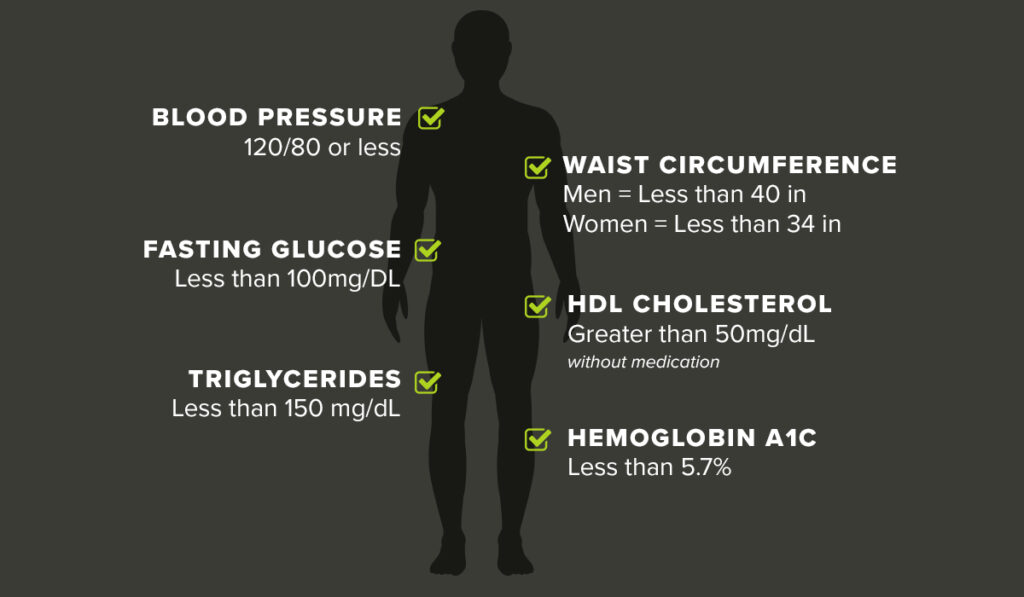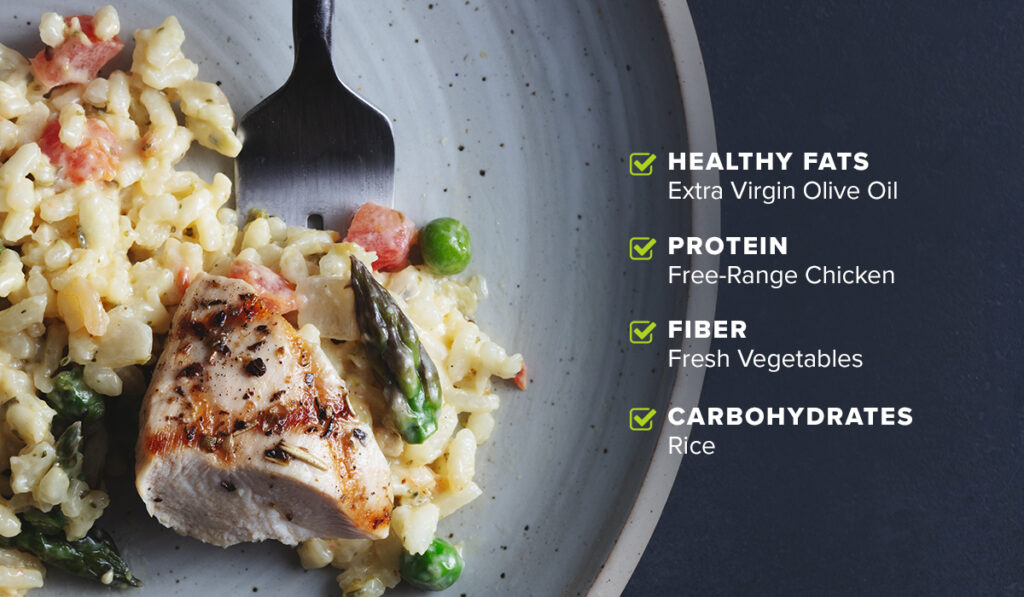Discussing what people tend to die from is decidedly not a fun topic. But when we learn about the leading causes of death, we empower ourselves to prevent them so we can live our best lives longer.
Heart disease, cancer, diabetes, stroke, and Alzheimer’s disease are all in the top10 leading causes of death in the United States. These deadly diseases have ties to lifestyle choices, including our nutrition, physical activity levels, and more. Changing your lifestyle can help you thwart chronic disease as much as possible.
Rest assured you don’t have to live a perfect life to live a healthier one. That would be boring. But stacking up more healthy choices can make life even better because you’ll have more energy, drive, and ability to do the things you love.

5 Big Leading Causes of Death
A harsh fact of life is that we aren’t immortal. But the good news is that we can take steps reduce our risk for these leading causes of death, giving us a better shot at living into our ’90s or even 100s, while feeling good. Here’s what you need to know about five major diseases that tend to take us down.
1. Heart Disease
Heart disease is the number one killer for all genders. It is an umbrella term to describe conditions such as coronary artery disease or other blood vessel issues, heart arrhythmias, and more. Some types of heart disease, such as congenital defects, can’t be prevented. But living a heart-healthy life can help either way.
2. Stroke
Stroke is a condition where the brain cannot get enough blood flow because of a blocked or burst vessel. Several conditions put you more at risk for stroke, including high cholesterol, heart disease, and more.
3. Diabetes
Diabetes is the seventh leading cause of death. Type 1 diabetes is an autoimmune disease. It is not currently preventable, but it can be managed. Most cases of type 2 diabetes, however, are preventable. Type 2 occur when the body no longer manages glucose and insulin properly. The root cause of Type 2 diabetes is insulin resistance. Before blood sugar levels progress to the status of diabetes, however, someone will develop prediabetes. And before that, they will have the start of insulin resistance.
4. Cancer
Cancer is the second leading cause of death. Cancer means some of the body’s cells grow uncontrollably and spread, leading to tumors, lumps, or issues with the blood. Cancer occurs for many reasons, some of them hereditary. But lifestyle factors can help reduce our risk for cancer.
5. Alzheimer’s
Alzheimer’s is the most common form of dementia. It starts with mild cognitive impairment before progressing to a debilitating disease. Although genetics may play a role in who develops Alzheimer’s, research also shows that lifestyle factors may be able to prevent it.
How To Tell If You’re At An Increased Risk For The Leading Causes Of Death
Investigating your metabolic health is a great starting point when it comes to assessing your disease risk. Heart disease, stroke, diabetes, cancer, and Alzheimer’s disease are linked to poor metabolic health, or how efficiently our body manages the processes of converting food into energy.
Only about 12% of people in the United States are metabolically healthy. Researchers often define metabolic health as having optimal levels of five factors without the use of medications to control those factors.

Five Factors for Metabolic Health
Optimal waist circumference: <102/88 cm for men/women
Optimal glucose levels: fasting glucose <100 mg/dL and hemoglobin A1c <5.7%
Optimal blood pressure: systolic <120 and diastolic <80 mmHg
Optimal triglycerides: <150 mg/dL
Optimal high-density lipoprotein (LDL) cholesterol: ≥40/50 mg/dL for men/women
If one or more of these factors is out of the healthy range for you, or you’re taking medications to control these factors, you may be at a higher risk for several of the leading causes of death. But that doesn’t mean you’re doomed. You might need to be on a blood-pressure lowering medication to control a heart arrythmia, even if you have normal blood pressure, for example. Additionally, you can take steps to adjust any out-of-range factors over time.
Note that you should not stop taking medications unless your doctor gives you the all-clear for doing so — if it’s even safe for you to do so.
You could have a few additional biomarkers tested to indicate whether you are at risk for these deadly age-related diseases.
Here Are A Few Things To Consider…
C-reactive protein. CRP is a marker of inflammation. Higher levels are associated with dementia, cancer, heart disease, and kidney disease. A normal level is less than 0.3 mg/dL. Keep in mind that a higher level could also indicate an autoimmune disease, and CRP is also slightly elevated during pregnancy, a cold, the flu, and more.
Apolipoprotein B. ApoB is a structural protein of cholesterol particles. An ApoB test may be a better biomarker for determining your risk for cardiovascular disease than the usual cholesterol tests. A normal ApoB level is less than 133 mg/dL for men and less than 117 mg/dL for women.
Fasting insulin. Insulin is a hormone made in your pancreas. High insulin levels can be an indicator of insulin resistance a decade or more before glucose levels indicate prediabetes or type 2 diabetes. A normal fasting insulin range is between 5 and 15 µU/mL. If your level is going up over time, that’s an indicator that you could be on a trajectory toward prediabetes.
Nutrition & Lifestyle Choices You Can Modify to Lower Your Risk of Deadly Disease
Overhauling your lifestyle can feel overwhelming at first. But you can start with one or two things and work your way to better metabolic health, and overall health, in baby steps that can have a big impact over time. Remember that a goal for better health is a lifelong journey, not a destination.
Making changes can help set you up for a longer health span. While lifespan is our time from birth until death, health span involves the years of your life you’re relatively healthy. A longer health span translates to more independence in your later years for smashing the competition on the pickleball court, keeping up with your grandkids at the park, or doing whatever it is you like to do.
Top 10 Things to Modify
Here are the top 10 things you can modify to reduce your risk for these five major causes of death.

1. Quit Smoking And Limit Alcohol
Smoking tobacco drives inflammatory processes all over the body and is a risk factor for most of the leading causes of death and other chronic diseases. If you don’t smoke, simply avoid starting. If you do smoke, talk to your doctor about a way to quit that’s right for you.
If you’ve noticed a movement from alcohol to non-alcoholic drinks, you’re not imagining the trend. Lots of people are reducing their intake of beer, wine, and spirits or quitting altogether. The word is out that even previously considered “safe” amounts of alcohol can increase one’s risk of liver disease. Aim to keep your alcoholic drinks to fewer than seven per week for women and 14 for men.

2. Get Optimal Sleep
If you don’t snooze, you lose. Adults need seven to nine hours of sleep per night for better health, including better metabolic health. Good quality and quantity of sleep are important for setting up your body’s metabolic processes for the next day. Poor sleep is associated with worsening metabolic health and puts you at risk for multiple chronic diseases.

3. Get Morning Sunlight
You don’t have to rise and shine, but if you can get a little shine first thing in the morning, you’ll set up your body’s internal clock, which helps control everything from your metabolism to your mood.

4. Reduce Stress
Stress less to feel your best. Chronic stress is linked to chronic disease, including cancer and type 2 diabetes. Aim to reduce your stress level through regular exercise, adequate sleep, taking time to relax, spending time with loved ones, and more.

5. Avoid Ultra-Processed Foods
Ultra-processed foods are designed to be ultra-tasty. But they are ultra-terrible for your health. They are loaded with chemical additives, sodium, added sugar, processed seed oils, and more, and have little nutritional value.
Ultra-processed foods are tied to an increased risk of death from multiple causes. In the United States, ultra-processed items make up 75% of food intake among adults. Making the bulk of your diet come from whole-food ingredients, rather than from highly processed foods, can dramatically improve your health.

6. Avoid Processed Seed Oils
Processed seed oils (think canola, soybean, sunflower, safflower, etc.) can drive inflammation, heart disease, cancer, and more. That’s because they are highly processed and have high levels of omega-6 fatty acids. In the United States, the high consumption of processed seed oils has skewed the ratio of omega-6’s to omega-3’s. Stick to olive or avocado oil as much as possible to boost your omega-3 intake.

7. Manage Blood Sugar
High glucose, also called blood sugar, is a contributing factor to many leading causes of death. This is the case even when someone’s blood sugar levels have not progressed to the level of type 2 diabetes. Reducing your intake of refined carbohydrates (bread, pasta, rice, etc.) can help prevent blood sugar spikes. Also skip on fruit juices, sugary sodas, and other sugary drinks, which drive up glucose levels.
Increasingly, people who do not have diabetes are trying continuous glucose monitors, whether ongoing or for a short time, to see how different foods affect their blood sugar and then creating nutrition strategies to keep their levels stable.

8. Pair Carbs With Other Nutrients
Controlling your blood sugar doesn’t mean you have to abstain from carbohydrates altogether. Instead, when you do eat carbohydrates, pair them with healthy fats, proteins, fiber, or a combination. These pairings help to slow the absorption of glucose into the blood stream, helping to lessen the chance of a blood sugar spike.

9. Get Your Cardio
Cardiovascular exercise is exercise that gets your heart rate up, such as running, cycling, swimming, rowing, hiking, high-intensity interval training, and even walking at a good clip. The CDC recommends getting 150 minutes of moderate-intensity exercise per week.
Cardio has many benefits in in addition to improving heart health, including controlling blood sugar, relieving stress, improving cholesterol levels, reducing inflammation, and keeping us mobile.

10. Build Muscle
You have nothing to lose with muscle gain. Unless we do something about it, after age 25, we tend to progressively lose muscle mass and function, which puts us at risk for frailty and falls in older age.
Plus, muscle is more metabolically healthy than fat, meaning you’ll burn more calories at rest with more muscle. Muscle also has protective benefits. It helps us control blood sugar levels, helps protect the heart, helps prevent osteoporosis, and more. More muscle mass is also associated with longevity, which is what we’re going for here.
Aim for at least two strength-training sessions per week, and ensure you’re consuming enough protein to support muscle protein synthesis for those good-for-you gains!

Final Take Away
To summarize, making mindful diet and lifestyle changes can significantly reduce the risk of the leading causes of death such as heart disease, stroke, diabetes, cancer, and Alzheimer’s disease. By focusing on metabolic health through improved nutrition, regular physical activity, adequate sleep, and stress management, individuals can extend their health span and enjoy a more vibrant, energetic life.
Embracing these changes doesn’t require perfection but rather consistent, healthier choices that cumulatively lead to a better quality of life and longevity.
About The Author: Jennifer Chesak, MSJ
Jennifer Chesak is an award-winning author, science and medical journalist, editor, and fact-checker, and her work has appeared in several national and international publications, including the Washington Post and BBC. Recently her debut nonfiction book on women’s health was awarded the IBPA Benjamin Franklin silver medal. Chesak earned her master of science in journalism from Northwestern University’s Medill. She currently teaches in the journalism and publishing programs at Belmont University, leads various workshops at the literary nonprofit The Porch, and serves as the managing editor for the literary magazine SHIFT. Find her work at jenniferchesak.com and follow her on socials @jenchesak.






